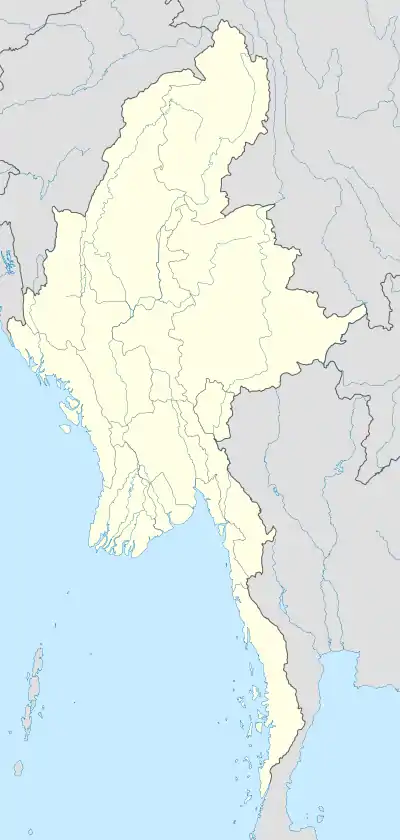
Putao (Burmese: ပူတာအိုမြို့) is the town in Kachin State, Myanmar and the principal town in Putao Township. The area around Putao is famous for its variety of birds and rare orchids, especially the so-called "Black Orchid" found in the mountains surrounding Putao. Myanmar's highest mountain, Hkakabo Razi, and other snow-capped peaks are visible from Putao.

History
Hkamti Long
Hkamti Long (also known as Khamti Long) is the former name of one of the outlying Shan States.[1] It was a princely state around the city of Putao settled by the Khamti Shan people. The name means "Great Place of Gold" in the Khamti Shan language.[2] Nowadays, there are Rawang and Lisu people, who are already regarded as Kachin nationalities. The seven-day-trek to West-Putao's mountain region, in which explorers found that there are Taron people ethnic whose height are lower than four feet. The population of this ethnic minority is so few nowadays that they are facing the threat of being extinct. The area covered by Hkamti Long may have included parts of what is now Kachin State (where Putao is located) as well as that of Shan State.[3]


World War II
A British military output, Fort Hertz, was established in 1914 and located near the town of Putao. Due to its remoteness, it was never captured by the Japanese military during the Burma Campaign, remaining in Allied hands throughout World War II. Although later disbanded, the remains of the fort are still visible.[4]
Geography
Putao is roughly 1,000 feet above sea level. Although surrounded by mountains, Putao itself is located on a plain.
Climate
The climate of Putao is a monsoon-influenced humid subtropical climate (Köppen Cwa) with a very high amount of precipitation throughout the monsoon season. The average temperature in January is 13.1 °C, while August is the hottest month with an average of 26.6 °C.
Transportation
Putao is a transportation hub for far-northern Myanmar, and commercial flights arrive seasonally at the town's airport.[4]
Tourist attractions
In addition to the mountains, the main attractions in the Putao area include rare orchids and herbs, Burmese Cordyceps (ရှီးပတီး), and Kaungmhulon, a Buddhist pagoda.
| Climate data for Putao (1991–2020) | |||||||||||||
|---|---|---|---|---|---|---|---|---|---|---|---|---|---|
| Month | Jan | Feb | Mar | Apr | May | Jun | Jul | Aug | Sep | Oct | Nov | Dec | Year |
| Record high °C (°F) | 26.5 (79.7) |
29.5 (85.1) |
34.5 (94.1) |
38.5 (101.3) |
37.0 (98.6) |
37.5 (99.5) |
38.0 (100.4) |
36.5 (97.7) |
35.0 (95.0) |
35.5 (95.9) |
30.5 (86.9) |
26.5 (79.7) |
38.5 (101.3) |
| Mean daily maximum °C (°F) | 21.1 (70.0) |
23.1 (73.6) |
24.9 (76.8) |
26.8 (80.2) |
29.3 (84.7) |
29.5 (85.1) |
29.3 (84.7) |
30.3 (86.5) |
29.8 (85.6) |
28.7 (83.7) |
25.7 (78.3) |
21.9 (71.4) |
26.4 (79.5) |
| Daily mean °C (°F) | 14.0 (57.2) |
16.5 (61.7) |
18.9 (66.0) |
21.4 (70.5) |
24.6 (76.3) |
26.0 (78.8) |
26.1 (79.0) |
26.6 (79.9) |
26.1 (79.0) |
23.8 (74.8) |
19.3 (66.7) |
14.8 (58.6) |
21.5 (70.7) |
| Mean daily minimum °C (°F) | 7.0 (44.6) |
9.8 (49.6) |
12.9 (55.2) |
16.0 (60.8) |
19.8 (67.6) |
22.4 (72.3) |
22.9 (73.2) |
22.9 (73.2) |
22.5 (72.5) |
18.9 (66.0) |
12.9 (55.2) |
8.0 (46.4) |
16.4 (61.5) |
| Record low °C (°F) | 1.5 (34.7) |
2.0 (35.6) |
6.0 (42.8) |
10.5 (50.9) |
13.5 (56.3) |
18.0 (64.4) |
16.3 (61.3) |
17.5 (63.5) |
18.3 (64.9) |
11.6 (52.9) |
5.0 (41.0) |
1.5 (34.7) |
1.5 (34.7) |
| Average precipitation mm (inches) | 19.4 (0.76) |
39.7 (1.56) |
99.4 (3.91) |
143.8 (5.66) |
228.7 (9.00) |
708.3 (27.89) |
1,088.9 (42.87) |
969.1 (38.15) |
696.9 (27.44) |
188.6 (7.43) |
23.5 (0.93) |
9.9 (0.39) |
4,216.2 (165.99) |
| Average precipitation days (≥ 1.0 mm) | 4.4 | 6.4 | 12.0 | 15.0 | 16.3 | 25.3 | 29.3 | 27.2 | 23.6 | 12.9 | 3.5 | 1.7 | 177.5 |
| Source: World Meteorological Organization[5] | |||||||||||||
See also
References
- ↑ Shan history Archived 2007-09-28 at the Wayback Machine
- ↑ Burma Library
- ↑ Chisholm, Hugh, ed. (1911). . Encyclopædia Britannica. Vol. 13 (11th ed.). Cambridge University Press. p. 540.
- 1 2 Schell, Orville (23 January 2015). "In Far-Flung Myanmar, a Land of Contradictions". New York Times. Retrieved 27 November 2023.
- ↑ "World Meteorological Organization Climate Normals for 1991–2020". World Meteorological Organization. Archived from the original on 17 July 2021. Retrieved 2 August 2023.

